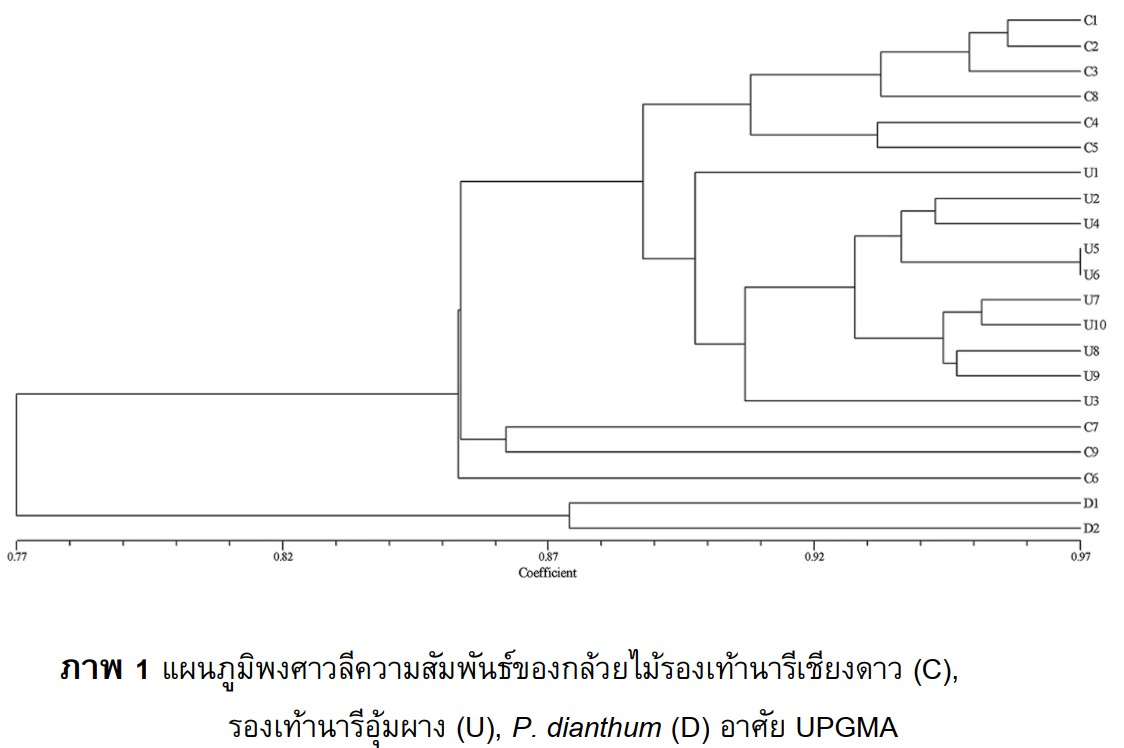ความสัมพันธ์ทางพันธุกรรมระหว่างกล้วยไม้รองเท้านารีหนวดฤาษีจากพื้นที่สอง จังหวัดภาคเหนืออาศัยเทคนิคเอเอฟแอลพ
คำสำคัญ:
พืชวงศ์กล้วยไม้, กล้วยไม้รองเท้านารีหนวดฤาษี, ความสัมพันธ์ทางพันธุกรรมบทคัดย่อ
กล้วยไม้รองเท้านารีหนวดฤาษี Paphiopedilum parishii (Rchb.f.) Stein นิยมเรียกชื่อตามแหล่งพบ อย่างเช่น รองเท้านารีเมืองกาญจน์ รองเท้านารีเชียงดาว สําหรับรองเท้านารีเชียงดาวบางรายงานยังเรียกชื่อวิทยาศาสตร์ Paphiopedilum dianthum Tang & Wang คณะผู้นิพนธ์มุ่งหมายศึกษาความสัมพันธ์ทางพันธุกรรมของรองเท้านารี หนวดฤาษีจาก 2 แหล่งของจังหวัดภาคเหนือ อาศัยเทคนิค amplified fragment length polymorphism (AFLP) ความ แตกต่างทางพันธุกรรมระหว่างประชากรค่อนข้างตํ่า ค่าเฉลี่ยร้อยละ 66.11
เอกสารอ้างอิง
2. Surin Peyachoknagul. DNA markers: from basic to application. Bangkok: Kasetsart University; 2009.
3. Doyle JJ, Doyle JL. Isolation of plant DNA from fresh tissue. Focus. 1990;12(1):13-15.
4. Vos P, Hogers R, Bleeker M, Reijans M, van de Lee T, Hornes M, et al. AFLP: A new technique for DNA fingerprintings. Nucleic Acid Res. 1995; 23:4407-4414.
5. Rolf FJ. NTSYSpc: Numerical taxonomy and multivariate analysis system version 2.1. User Guide. New York: Exeter Setauket; 2000
6. Nei M, Li WH. Mathematical model for studying genetic variation in terms of restriction endonucleases. Proc Natl Acad Sci U S A. 1979;76(10):5269-5273.
7. Nei M. Genetic distance between populations. Am Nat. 1972; 106:283-292.
8. Sneath PHA, Sokal RR, Numerical Taxonomy: The principles and practice of numerical classification. San Francisco: Freeman WH and Company; 1973.
9. Yeh FC, Yang RC, Boyle T. Popgene. Microsoft Window- based freeware for population genetic analysis. Release 1. 31. Canada; University of Alberta; 1999.
10. Wanichkul J, Changtragoon S. Investigation of genetic diversity of Paphiopedilum exul by using AFLP (amplified fragment length polymorphism) markers. Proceeding of biodiversity Research from the past to the future; 2005 Aug 21-24; Phetchaburi, Thailand.
11. Frankham R, Ballou JD, Briscoe DA. Introduction to conservation genetics. Cambridge: Cambridge University Press; 2002. 617 p.12. Li A, Luo YB, Xiong ZT, Ge S. A preliminary study on conservation genetics of three endangered orchids species. Acta Botanica Sinica. 2002;44(2):250-252.

ดาวน์โหลด
เผยแพร่แล้ว
รูปแบบการอ้างอิง
ฉบับ
ประเภทบทความ
สัญญาอนุญาต
ผู้นิพนธ์ต้องรับผิดชอบข้อความในบทนิพนธ์ของตน มหาวิทยาลัยพะเยา ไม่จำเป็นต้องเห็นด้วยกับบทความที่ตีพิมพ์เสมอไป ผู้สนใจสามารถคัดลอก และนำไปใช้ได้ แต่จะต้องขออนุมัติเจ้าของ และได้รับการอนุมัติเป็นลายลักษณ์อักษรก่อน พร้อมกับมีการอ้างอิงและกล่าวคำขอบคุณให้ถูกต้องด้วย







